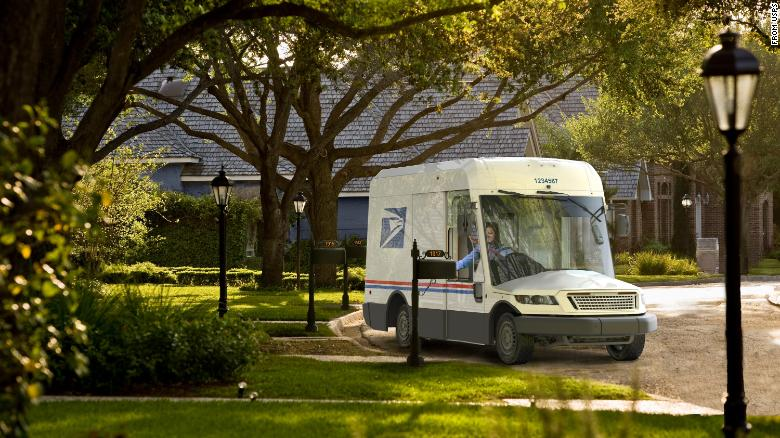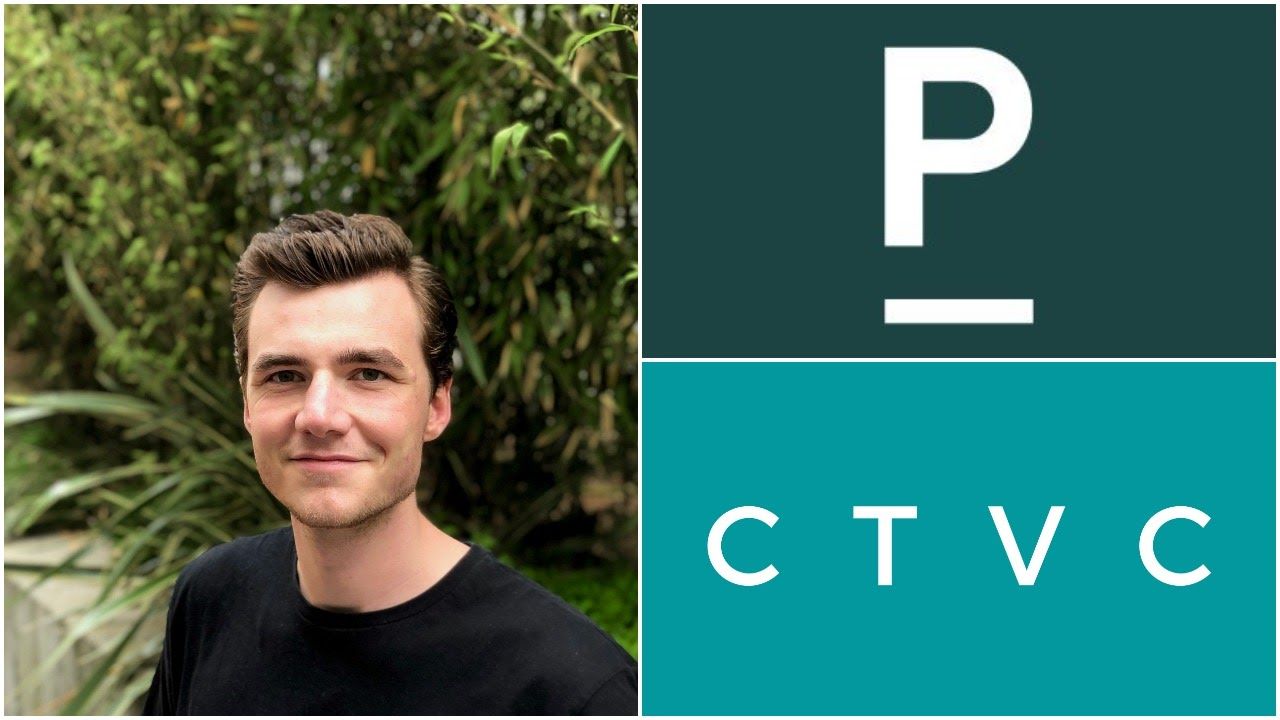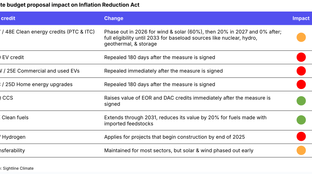
🌎 Overheard at LCAW #252
Climate, capital, and carrots in London's new playbook
Even if it quacks (or SPACs), it might not be EV
Happy Monday! In this week’s issue, we cover the maladies of the USPS’ mallard-shaped trucks not getting the buzzy treatment Biden had promised for an all electric federal fleet.
We also feature Patch, which uses their digital era calling card of four lines of code to usher carbon offset marketplaces into the mainstream of consumer tech (and who just became a16z’s latest climate investment). CEO Brennan Spellacy shares his views on the rising appetite for carbon removal from corporates and on making the market for permanent forms of carbon removal.
After that, news on four more EV SPACs, a riveting round-up of jobs, and a bevy of alternative protein startup raises.
Thanks for reading!
Not a subscriber yet?

It’s a bird! It’s an EV! It’s my mail? USPS unveiled its (duck-like) next generation delivery vehicle – decked out with a rear-view camera, more cargo space, and a hood designed not to kill you. The contract for these vehicles was given to Oshkosh Corp., which is expected to build 50,000 to 165,000 trucks over the next 10 years. Oshkosh stock rose by 16% at the news while its competitor’s, Workhorse Group Inc. dropped by 60%. (They were relying on the bid win.)
The fleet (flock?) of EVs, however, will likely be limited. The USPS currently operates 225,000 vehicles – the largest part of the federal fleet – but plans for only 10% of its new trucks to be electric. Oshkosh’s design will be manufactured as both an electric or internal combustion engine. According to the USPS Postmaster General, committing to a greater number of EVs would be too expensive...
This news conflicts with Biden’s vow to replace the U.S. government’s fleet of roughly 650,000 vehicles with electric models. Unless USPS rounds up its existing ICEs and retrofits them with electric powertrains soon, this new purchase order paves the road for a long future of gas guzzlers - the average lifetime for a USPS truck is 28 years!
Corporate contracts like Amazon and Rivian’s or government contracts like this one have become make-it-or-break-it moments for EV startups. What happens to the second place finishers? We’ll be watching Oshkosh vs. Workhorse’s stock.
🌱 Anuvia, a Winter Garden, FL-based developer of bio-based fertilizer, raised $103m in Series C funding from TPG ART, Pontifax Global Food and Agriculture Technology Fund, Generate Capital and Piva Capital. More here.
⚡ Malta, a Cambridge, MA-based developer of long-duration energy storage solutions, raised $50m in Series B funding from Proman, Dustin Moskovitz and insiders Alfa Laval and Breakthrough Energy Ventures. More here.
🏢 Blocpower, a Brooklyn, NY-based provider of energy efficiency solutions for urban buildings, raised $8m in Series A equity funding and $55m in debt from American Family Insurance Institute, AccelR8, Goldman Sachs, Kapor Capital, CityRock Venture Partners, Salesforce Ventures, Elemental Excelerator and Schmidt Family Foundation. More here.
⚡ WiTricity, a Watertown, MA-based wireless charging solution maker, raised $18m in funding from Future Shape and other private investors. More here.
🔋 Nyobolt, a UK-based auto battery startup, raised $10m in Series A funding from IQ Capital and Cambridge Enterprise.More here.
🍔 Mosa Meat, a Netherlands-based creator of a cultivated beef hamburger, raised $10m in its final close of its Series B funding round from Nutreco and Jitse Groen. More here.
🐔 Next Gen, a Singapore-based maker of plant-based poultry, raised $10m in Seed funding from Temasek, K3 Ventures, Blue Horizon, and others. More here.
🌱 HowGood, a New York, NY-based sustainability database for the food and personal care industries, raised $6m in Series A funding from Contour Venture Partners, FirstMark Capital, Danone Manifesto Ventures and Trailhead Capital. More here.
🏗️ Bloom Biorenewables, a Switzerland-based startup developing products designed to substitute fossil-sourced carbon in materials and fuels, raised $5m in Seed funding from Breakthrough Energy Ventures-Europe. More here.
💨 Patch, a San Francisco, CA-based platform for carbon mitigation, raised $4.5m in Seed funding from Andreessen Horowitz, VersionOne, Pale Blue Dot, and Maple VC. More here.
⚡ ChargeLab, a Canada-based provider of EV charging software, raised $4m in Seed funding from Construct Capital and Root Ventures. More here.
🐔 Better Origin, a UK-based startup that converts food waste into chicken feed, raised $3m in Seed funding from Fly Ventures and Metavallon VC. More here.
🌱 Natural Fiber Welding, a Peoria, IL.-based textile fibers company, raised $2m from Allbirds. More here.
Lucid Motors, a maker of luxury EVs, will go public via reverse merger with SPAC Churchill Capital IV, valuing the firm at $24b. More here.
ReNew Power, India’s largest renewable energy firm, agreed to go public via reverse merger with SPAC RMG Acquisition Corp., valuing the firm at $8b. More here.
Joby Aviation, a maker of an all-electric, vertical take-off and landing aircraft, will go public via merger with SPAC Reinvent Technology Partners, valuing the firm at $6.6b.
Xos Trucks, a provider to the medium- and heavy-duty last-mile commercial electric vehicle market, will go public via merger with SPAV NextGen Acquisition, a SPAC, valuing the firm at $2b.
Enovix, a maker of lithium-ion batteries, will go public via merger with SPAC Rodgers Silicon Valley Acquisition, valuing the firm at $1.1b.
2150 just launched as a new VC fund focused on making Europe’s cities greener.
Chevron raised $300m for its second Future Energy Fund committed towards low-carbon technology investments.

We caught up with Brennan Spellacy, CEO of Patch, about the platform for negative emissions which just became Andreessen Horowitz’s latest climate investment. Brennan explains how Patch removes companies’ carbon with just four lines of code, and the company’s perspective on how carbon offsets complement - don’t detract from - work to decarbonize operations. [We edited the newsletter version lightly for length; read the full interview here].
What led you to start Patch?
I studied chemical engineering at McGill with the intention of working in renewable energy. Instead I ended up becoming a programmer at Shopify and working with my now co-founder, Aaron, at Sonder. We left that job with a 10-page pitch deck and a desire to bring our career arcs back to climate.
We built Patch on the premise that climate can be addressed through two broad buckets: 1) decarbonization and 2) carbon removal. Although there’s still a massive amount of work to be done on decarbonization, we actually felt like the Zeitgeist of decarbonization had hit. Whether it’s the levelized cost of renewables reaching coal, Tesla making EVs cool, or Gen-Zs shopping consciously, decarbonization has become mainstream. Compare that to carbon removal, where the climate models have us needing to remove 10-15 gigatonnes of CO2e per year and yet society has barely gotten started. Patch is our attempt to kickstart the carbon removal part of the puzzle.
Why are APIs a powerful approach for this use case? Walk through how a company would integrate Patch into their business.
Simply put, an API is an interface that a computer can understand. An API allows programmers to write interactive software - like a Lego brick which can be built into a host of different software systems.
As an example, with our integration with TripActions, a corporate travel and expense management platform, customers can natively decide if they want to neutralize or partially compensate their travel emissions. One of our early customers, Carbon Zero, launched a credit card where they dedicate a piece of the purchase to carbon removal. Without the 3-5 lines of Patch’s API code, none of these use cases would be possible given the scale and complexity of manually incorporating carbon removal into workflows.
Who are your customers today?
We’re working with a host of tech-enabled, ecommerce, logistics, finance, and banking companies. In addition to TripActions and Carbon Zero, our initial customers have been in the travel & hospitality and fintech spaces. Sonder is a customer, as are a couple of private equity funds who are not only neutralizing their own operational footprint, but are extending the service to their portfolio companies. Payments companies are also highly attune to what Stripe and Shopify are doing with carbon removals, and trying to decide if they should build a tool in house, or use a third party vendor like Patch. It’s the classic build versus buy debate.
Are these customers taking steps to decarbonize in addition to paying for removals?
Yes, most of our customers are also attempting to decarbonize - that’s actually why Patch is so compelling for them. I tweeted about this. Typically sustainability teams will have half of their headcount spending time on decarbonization approaches, and the other half working on deploying the carbon program budget. Because Patch abstracts away the complexity of handling carbon programs and earns individual companies better negotiating power, a company’s full sustainability team can now focus on internal decarbonization. We see Patch as complementary to decarbonization, as opposed to an alternative replacement.
Do customers get to pick their removals suppliers?
We’re very transparent about our vendors - so much so that you’d have enough information to go around Patch if you wanted to try and manage the vendor relationship directly. In practice, customers stick to our platform since going direct takes longer, is more expensive, and is operationally complex to ensure proper fulfillment. We offer pre-built portfolios based on a company’s budget and volume demand, but also allow complete flexibility and authority to custom select. We’re actually not opinionated about specific types of technologies or approaches, but instead ensure that the data is comprehensive and easy to understand so that our customers have the power to make decisions.
How do you see yourself integrating or working with existing carbon marketplaces, verifiers, and audit services (e.g., CarbonChain, Persefoni, Sinai)?
Anyone can use the API, but for the most part anything that claims to be a marketplace is primarily going to be competitive - similar to how Airbnb competes with Expedia and Booking.com for listings. We do sell to the carbon accounting tools, which focus on emissions quantification, reduction, and compensation (aka carbon removal). The compensation piece is a must have feature for these products, but it isn’t a differentiator - which makes it a great choice to buy vs build. You can think of Patch as the “Plaid” for carbon accounting. But I like to think of Plaid as the Patch for banking.
As more companies (like Sweetgreen this week) do the hard operational work to reduce their carbon footprints, how do you see the role of carbon removal fitting in?
Patch exists for the reason that this decarbonization work is hard; companies shouldn’t spend people power on carbon offsets and removals. There’s a sizable portion of decarbonization that’s fairly straightforward (e.g., tweaking operations, traveling less), but the later incremental avoided tonnes get much harder. When marginal decarbonization actions are no longer aligned with cost cutting (because expensive capex retrofits are the only pathway), then paying for removal in the short term is a fast way to drive impact, while simultaneously working towards decarbonization in the long term. That’s why we need to reach a meaningful scale in carbon removal demand to drive down the cost curve and make removals more cost competitive with difficult decarbonization work.
What will it take for permanent carbon removal solutions to compete on price with temporary nature-based pathways?
The key piece will be to siphon more capital towards permanent forms of carbon removal. The challenge is that there hasn’t historically been an easy way to build an entire portfolio of permanent carbon removals. We have one client who spends $1m / year on nature-based or avoidance offsets. We’ve worked with them to carve out 30% of that $1m budget to go towards permanent carbon removal. Replicated over many large offset budgets over the next few years, we can start to see a world where demand for carbon removals actually traverses the cost curve fairly quickly.
Some of our carbon removal suppliers anticipate that at a few megatons of scale, they’ll be able to cut prices down ~80%. Scale doesn’t just correlate with better technology, but it also means better cost of capital. As corporate demand for carbon removal ramps up and suppliers can show repeatable demand, the per unit cost comes down, which in turn increases demand, and so on so forth. We think that the permanent removals market will act very similarly to how solar played out a few decades ago when it quickly dropped from $40.00 / kWh to now $0.04 / kWh - and crushed coal out of the market.
You just raised a $4.5m Seed round led by Andreessen Horowitz. Congratulations! How serious are a16z’s climate motivations?
Andreessen and Sequoia have both started picking up the pace on their climate investments. Sequoia just backed Joro and Watershed, which is great. Jeff Jordan, at a16z, was the one who led our deal and is a very climate focused person. If you look at some of his other deals, like Lime which replaces cars with electric last mile solutions, he’s invested a lot in climate adjacent-areas - although Patch is more “climate-direct.” In addition to his personal climate ethos, Jeff specializes in marketplaces. Along with Bill Gurley and Sarah Tavel, you can’t really get a better marketplace mind than Jeff Jordan.
Are you interested in helping to build the “Plaid” for carbon removal? Patch is hiring across engineering, design, sales and marketing. Are you interested in how four lines of code can make your company carbon neutral / negative? Check out Patch.io for how to get set up.
Electricity customers in Texas want answers about their $15,000 bills and the state is well into the finger pointing stage - spurring a flurry of investigations from the Public Utility Commission of Texas, Texas Attorney General and Governor, and the House Energy and Commerce Committee.
Jennifer Granholm, the former Michigan governor, was confirmed as head of the DOE in a 64-35 vote. She faces a high order to expand clean energy as noted by Axios.
Highland Electric Transportation, which raised $253m last week, announced it was awarded the largest electric school bus fleet contract by Maryland’s Montgomery County. You know what they say - if it quacks or SPACs, it’s probably an EV!
Sweden will be home to H2 Green Steel, the largest green hydrogen steel venture, with production beginning in 2024 and scaling to 5M tons by 2030.
Etsy and Sweetgreen are going net zero, and doing more than just joining the commitment party (by 2030 and 2027 respectively) - Watershed will power their decarbonization journeys.
A Brookings study analyzing fossil fuel employment finds an “impressive overlap between where fossil fuel jobs are now and where renewable generation could be.” In other words, the transition to green jobs is more than feasible.
Analyzing the flow of money to 934 companies on the Global Coal Exit List, a recent report found that banks increased monetary provisions to coal-related companies by at least 11% since 2016. BlackRock, hot off the pulpit of a “net-zero world,” has the second largest coal-related institutional investment holdings (totaling $84b).
With the US all a flutter about its new postal fleet design, Amazon India has been busy deploying 10,000 Mahindra Treo Zor three wheeler electric rickshaws for delivery.
Mechanical Engineer, Grace Li, shares tips on breaking into climate as a ME.
The Diamond List has dropped its open-sourced list of the most impactful climate tech startups “in the rough” which investors think are undervalued. Email [email protected] for intros or the data table.
Longform weekend read on the (dirty) history of environmental justice and why it’s getting the attention it deserves in 2021.
Li batteries and green H2 take 2 out of 10 spots in MIT Technology Review’s annual list of technology breakthroughs. What moonshots are the stars betting on? For starters, Bill Gates is long nuclear fusion.
For all the net zero wonks, Google just released their methodology on achieving carbon-free energy by 2030.
💡 Shell Startup Engine: Energy startups operating in or entering the UK market can apply on a rolling basis to be part of the accelerator program.
💡 CalTestBed: Startups based in California can apply by March 19th to test their innovations at 1 of 60 participating testbeds at Lawrence Berkeley National Lab and 9 University of California campuses.
Sustainability + Climate Risk VP @BlackRock
Investor, Intern @G2VP
Director of Impact @Prime Coalition
Partnerships Associate @Prime Coalition
Associate @Croatan Institute
Jr Product Designer @Rivian
Social Good, Product Mgmt Interns @Impossible Foods
Strategy Associate @Better Place Forests
Feel free to send us new ideas, recent fundings, or general curiosities. Have a great week ahead!

Climate, capital, and carrots in London's new playbook

US plays popcorn politics with biofuels and beyond

Groundbreaking results from the geothermal developer’s main project